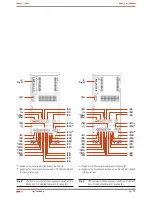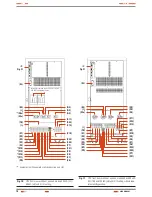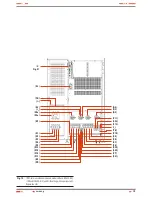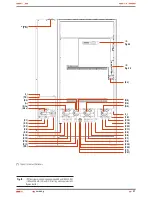
8
devices type B and circuit breakers with C characteristic or any
other equivalent one).
For equipments with three phase input, and connected to an IT
distribution system, the protection will be four poles in order to
break the three phases and neutral in the same manoeuvring.
Overload conditions are considered as a non-permanent and ex-
ceptional operating mode, so these currents will not be kept in
mind when sizing the protections.
• Do not overload the UPS by connecting loads with inrush con-
sumptions at its output, i.e. laser printers.
• Installations with redundant equipments or separate bypass
line, there will be one and common RCD device only of 300 to
500mA for both lines at the beginning of the installation.
• It is recommended to distribute the output power, into four lines
as minimum. Each one of them will have a protection circuit
breaker sized to the quarter of the nominal power. This kind of
outgoing distributions will allow that any fault in any device con-
nected to the equipment, that makes a short-circuit, will affect
to the line with the failure only. Power supply will be guaranteed
to the rest of connected loads, because of the tripping of the
affected line by the short-circuit only.
• Under any concept the input power cables will be connected to the
output of the equipment, either directly or through other outlets.
•
When supplying input voltage to a UPS with static by-
pass or separate bypass line, the fact of having the in-
verter «Off» (shutdown), it doesn’t mean to not have voltage at
the output terminals.
To not have it, input and static bypass switches have to be
turned «Off».
Put warnings labels and/or emergency switches in the partic-
ular installation if the safety norms require it.
•
It is possible that the UPS supplies output voltage through
the manual bypass to those equipments that incorporate it
either standard or optional, so it will have to be considered as re-
gards to safety.
If it were necessary to break the output supply of the equipment in
this situation, turn off the outgoing distribution protection or in lack of
it, turn off the general protection of the distribution panel that feeds
the UPS.
• All the equipments have two auxiliary terminals to install an
external emergency power off button (EPO), which will belong
to the end-user.
EPO doesn’t affect to the power supply of the equipment, it only
breaks the power supply to the loads as a safety measure.
• RACK mounted equipments are destined to be installed in a predeter-
mined set to be done by professionals.
Its installation has to be designed and executed by qualified
personnel, who will be the responsible to apply the safety
and EMC regulations and standards that controls the par-
ticular installations where the product is destined.
2.2.3. Safety warnings regarding batteries.
•
The manipulation and connection of the batteries shall
be done and supervised by
personnel with battery
knowledge
only.
Battery circuit is not isolated from input voltage, it is dangerous
to touch any part of the batteries. Dangerous voltages can be
found between the terminals of the battery set and the earth.
Check that there is not any voltage at the input before taking
any action over them.
• Before doing any action inside the UPS, disconnect the batteries.
Check that no voltage is present and there is not potential danger in
the DC BUS (capacitors) or in the endpoint of the battery set terminals.
• In equipments with separate battery cabinet, check that they
are compatible before connecting them.
• When faulty batteries are replaced, the complete battery set
has to be replaced, less exceptional cases in new equipments,
were due to manufacturing faults it will only be replaced the
defective ones.
The replacement will be done by another one of the same type,
voltage, capacity and quantity. All of them has to be of the
same brand. Otherwise there is risk of explosion.
• Do not reuse faulty batteries. There could be an explosion or
burst any battery with the involved problems and issues that
could happen.
• Generally supplied batteries are installed in the same cabinet,
case or rack of the equipment. Depending on the power, au-
tonomy or both, they can be supplied separately from the equip-
ment in another cabinet, case or rack, with the interlink cables
among them. Do not modify its length.
• In those equipments requested without batteries, their acquisi-
tion, installation and connection of themselves will be done by
the end-user and
under his responsibility
. Data concerning
the batteries as regards to quantity, capacity and voltage, are
stated in the battery label sticked beside the nameplate of the
equipment.
Respect
these data, battery connection polarity
and the supplied circuit diagram strictly.
For an optimum and efficient operating, the battery set has to
be located as close as possible to the equipment.
•
Battery voltage can involve the risk of electric shock and
can produce high short circuit currents. Observe the fol-
lowing preventive measures before manipulating any terminal
block identified in the labelling as «Batteries»:
Use the suitable IPE (Individual Protection Equipment):
gloves and insulated shoes, protection glasses, suitable
work clothes, ...
Take off rings, bracelets or other metal hanging objects.
Use tools with insulated handles.
Disconnect the corresponding protection elements.
When connecting a battery cabinet to the UPS, respect the
cable’s polarity and colour (red-positive; black-negative) in-
dicated in the manual and labelling.
Do not place metal tools or objects over the batteries.
Risk of short-circuit and possible deflagration due to the ac-
cumulated hydrogen.
Metallic particles of different sizes can be thrown due to
the violent explosion of the short-circuit and/or the tool it-
self or the metallic object, which origin the incident, with
the risk of significant damage to nearby people and other
devices, instruments or machines.
Never manipulate them with your hands or through con-
ducting objects, do not short either the battery terminal
block of the equipment or the own ones from the batteries.
USER MANUAL









































